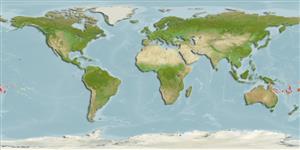Klassifizierung / Names
Namen | Synonyme | Catalog of Fishes(Gattung, Arten) | ITIS | CoL | WoRMS | Cloffa
>
Ovalentaria/misc (Various families in series Ovalentaria) >
Pomacentridae (Damselfishes) > Pomacentrinae
Etymology: Amphiprion: Greek, amphi = on both sides + Greek, prion, -onos = saw (Ref. 45335); barberi: Named for Dr. Paul Barber of Boston University, USA, for his contributions regarding genetic relationships of Indo-Pacific coral reef organisms..
Environment: milieu / climate zone / depth range / distribution range
Ökologie
seewasser riff-verbunden; tiefenbereich 2 - 10 m (Ref. 78105). Tropical
Central Pacific: Fiji, Tonga and American Samoa.
Size / Gewicht / Alter
Maturity: Lm ? range ? - ? cm
Max length : 8.6 cm SL Männchen/unbestimmt; (Ref. 78105)
Kurzbeschreibung
Morphologie | Morphometrie
Rückenflossenstacheln (insgesamt): 10; Rückenflossenweichstrahlen (insgesamt): 16-18; Afterflossenstacheln 2; Afterflossenweichstrahlen: 14. This pomacentrid species is distinguished by the following characters: D X, 16-18 (usually X, 17); A II, 14; pectoral rays 18 (rarely 17); tubed lateral-line scales 36-43; gill rakers 5 + 12-14 (total 17-19); opercular spinules 11-19; body depth 1.7-1.9 in SL; body color generally red-orange including fins, grading to brownish on upper back of adults and a single white bar immediately posterior to the eye, its greatest width equal to that of eye or greater, narrowing to one-third to one-half of greatest width at dorsal midline (Ref. 78105).
The species is common on coral reefs, about 2-10 m and is generally commensal with large sea anemones, either Entacmaea quadricolor (Rüppell & Leuckart, 1828) or
Heteractis crispa (Ehrenberg, 1834). It is usually seen in groups that swim a short distance above their host anemones, apparently feeding on zooplankton. Reported to have been frequently encountered on local reefs in about 6-8 m depth, usually in association with Entacmaea quadricolor (Paul Brown, National Park of American Samoa, pers.comm.) (Ref. 78105). Oviparous, distinct pairing during breeding (Ref. 205). Eggs are demersal and adhere to the substrate (Ref. 205). Males guard and aerate the eggs (Ref. 205).
Life cycle and mating behavior
Geschlechtsreife | Fortpflanzung | Ablaichen | Eier | Fecundity | Larven
Oviparous, distinct pairing during breeding (Ref. 205). Eggs are demersal and adhere to the substrate (Ref. 205). Males guard and aerate the eggs (Ref. 205).
Allen, G.R., J. Drew and L. Kaufman, 2008. Amphiprion barberi, a new species of anemonefish (Pomacentridae) from Fiji, Tonga, and Samoa. aqua, Int. J. Ichthyol. 14(3):105-114. (Ref. 78105)
IUCN Rote Liste Status (Ref. 130435)
Bedrohung für Menschen
Harmless
Nutzung durch Menschen
Mehr Information
NamenSynonymeMetabolismusRäuberÖkotoxikologieFortpflanzungGeschlechtsreifeAblaichenSpawning aggregationFecundityEierEientwicklung
Alter/GrößeWachstumLänge-GewichtLänge-LängeLängenhäufigkeitenMorphometrieMorphologieLarvenLarven Pop.Dyn.RekrutierungDichteBRUVS
ReferenzenAquakulturAquakultur ProfilZuchtlinienGenetikElectrophoresesVererbbarkeitKrankheitenVerarbeitungNutrientsMass conversion
PartnerBilderStamps, Coins Misc.LauteCiguateraGeschwindigkeitSchwimmstilKiemenoberflächeOtolithsGehirngrößeSehfähigkeit
Tools
Zusatzinformationen
Download XML
Internet Quellen
Estimates based on models
Preferred temperature (Ref.
123201): 25.8 - 29, mean 27 °C (based on 256 cells).
Phylogenetic diversity index (Ref.
82804): PD
50 = 0.5000 [Uniqueness, from 0.5 = low to 2.0 = high].
Bayesian length-weight: a=0.02344 (0.01149 - 0.04783), b=2.99 (2.82 - 3.16), in cm total length, based on LWR estimates for this (Sub)family-body shape (Ref.
93245).
Trophic level (Ref.
69278): 2.7 ±0.3 se; based on size and trophs of closest relatives
Widerstandsfähigkeit (Ref.
120179): hoch, Verdopplung der Population dauert weniger als 15 Monate. (Preliminary K or Fecundity.).
Fishing Vulnerability (Ref.
59153): Low vulnerability (10 of 100).
